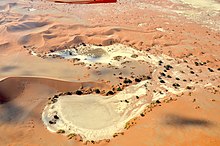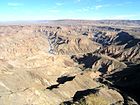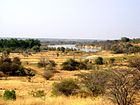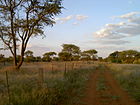Namibia
![]()
The title of this article is ambiguous. For other meanings, see Namibia (disambiguation).
Template:Infobox State/Maintenance/NAME-German
Namibia (officially: Republic of Namibia; German pronunciation: [naˈmiːbi̯a]; English Republic of Namibia) is a state in southern Africa between Angola, Botswana, Zambia, South Africa and the Atlantic Ocean. A border of up to 100 metres - and thus the only four-country corner on earth - with Zimbabwe is disputed.
The dry landscape was originally settled by the San ("Bushmen") and Damara peoples. Since about the 14th century, Bantu migrated into the country in the course of the Bantu migration. The area of present-day Namibia became a German "protectorate" in 1884 and remained a German colony called German Southwest Africa until the end of World War I. Between 1904 and 1908, the German colonial power violently put down the uprising of the Herero and Nama, thus committing genocide. In 1920, the League of Nations placed Namibia under South African mandate - effectively as a South African colony - which introduced its own laws, such as those on apartheid, into Namibia.
Namibia gained independence from South Africa in the course of the Namibian Liberation Struggle on 21 March 1990 - with the exception of Walvis Bay and the Penguin Islands, which were under South African control until 1994. March 21 has been the country's national holiday ever since. The capital and largest city of Namibia is Windhoek. The country has been a member of the United Nations (UN), the Southern African Development Community (SADC), the Southern African Customs Union (SACU), the African Union (AU) and the Commonwealth of Nations since 1990 (Resolution 652).
Namibia is very sparsely populated due to the large area of the Namib. The country has about 2.3 million inhabitants. 18 percent of the population lives below the Namibian poverty line (as of November 2016), down from 28.7 percent in 2009. Namibia has a stable parliamentary democracy. The Namibian economy is strongly influenced by agriculture, tourism and mining (uranium, gold, silver and base metals).
Etymology
The name of the state is derived from the Namib, which occupies the entire coastal area of the country. It was chosen as a neutral name at independence in order not to disadvantage any of the many Namibian peoples. Mburumba Kerina is considered the creator of the name Namibia.
On 12 June 1968, the name Namibia was recognised by the General Assembly of the United Nations.
Geography
→ Main article: Geography of Namibia
Namibia lies between 17.87° and 29.9808° south latitude and 12° and 25° east longitude.
Namibia is bordered by the Kalahari to the east of Botswana, the Orange River to the south of South Africa, the South Atlantic Ocean to the west and the Kunene and Okavango rivers to the north of Angola. In the northeast there is also a land finger about 450 km long and up to 50 km wide between the northern bordering countries Angola and Zambia and the southern bordering Botswana - the Caprivi Strip, which is bordered in the eastern area by the Zambezi and the lower reaches of the Kwando.
In addition to the border rivers mentioned above, there are numerous other rivers, none of which, however, carries water all year round with any certainty. Outside the rainy season, only dried up river beds (Riviere) can be found.
The entire national territory of Namibia covers about 824,292 square kilometres. Namibia's landscape is essentially characterised by two deserts, in the west by the Namib, which extends from the South African province of the Northern Cape far into Angola, and in the east by the Kalahari. Between the two deserts lies the inland highlands, which are on average 1700 metres high and around the capital Windhoek also exceed the 2000-metre mark. One of the most prominent mountains is the Etjo, but the highest mountain is the 2600 metre high Königstein in the Brandberg massif, near the coast, about 200 kilometres north of the coastal town of Swakopmund. To the east, the inland highlands gradually merge into the Kalahari highlands, which are around 1200 metres high and covered in dry vegetation.
Time zone
→ Main article: Legal time in Namibia
Namibia has used the same time as South Africa (UTC+2) all year round since 3 September 2017, as it did between 1990 and 1994.
Geology
The area of today's Namibia is considered one of the oldest parts of the earth's crust. Long before the formation of the supercontinent Gondwana, two shelves formed in the area of today's Africa more than two billion years ago: the Congo Craton and the Kalahari Craton. The latter covers large parts of present-day Namibia. Through various tectonic processes, a huge, coherent continental area was then formed about 550 million years ago, which included today's (partial) continents of Africa, South America, Australia, India and Antarctica: Gondwana.
About 150 million years ago, this supercontinent gradually began to break up and drift apart into the continents we know today. The special climatic conditions in Southwest Africa, which lasted for millions of years, led to the fact that many geological structures, processes and phenomena are particularly well preserved and can therefore still be observed today. Ultimately, this also includes the Namib, which can thus be considered the oldest desert in the world.
·
Fish River Canyon
· 
NamibRand Nature Reserve - Wolwedans
·
Okavango near Rundu
·
Farm road near Omaruru
· 
Namib
Climate
The average climate of Namibia is hot and dry. The largely arid climate is subtropical continental. There are large differences between the individual parts of the country:
Rainfall is extremely rare in the Namib west of the break-off stage. There is a warm, strong wind all year round. Even in winter, temperatures often reach 25°C and more. In the hottest summer months, December and January, temperatures are usually well above 30 °C, while in the coldest months, July and August, they can drop to freezing point at night, but then rise again to around 25 °C during the day. In the mornings and evenings, especially in winter, temperatures can jump by more than 20 °C within a few hours. In the inland highlands, due to the high altitude, there can even be frost at night and, in very rare years, snowfall. During the day it is not quite as hot as in the desert. The Kalahari is similar to the Namib. The precipitation is a little more frequent, but still desert-typical rare.
The area between the Namib and the Atlantic Ocean is one of the regions with the best climate for astronomical observations worldwide. The astro camps established there are therefore visited by many star lovers, especially for the purpose of sky photography.
The climate of the Atlantic coast, in turn, is determined by the cold Benguela Current. This strongly cools the prevailing southwest wind, which prevents the formation of (rain) clouds due to condensation and regularly creates a dense persistent fog near the ground. In summer it is pleasantly cool here and in the winter months it can sometimes be very cold during the day. The water temperature rarely reaches more than 15 °C.
The Caprivi Strip, on the other hand, is characterised by mostly reliable rainfall during the rainy season. These have given rise to an extensive river system and a subtropical savannah forest. The humidity is relatively high here, in contrast to the other parts of the country.
In the central highlands, which cover most of Namibia, summer rains prevail, i.e. irregular but occasionally very heavy rainfall can be expected between November and April; the extreme south, on the other hand, is in the winter rainfall area, so that - if at all - rainfall occurs mainly in the months of June and July. Despite the irregularity of the rainfall in terms of frequency and yield, it increases significantly from the south with less than 50 mm per year towards the northeast with up to 600 mm per year, which, however, does not exclude regional dry periods of several years.
Due to the special climatic conditions, agricultural use of the land is only possible to a limited extent: in the highlands mainly cattle breeding (in the north rather cattle, in the south rather sheep and goats), in the relatively rainy north also agriculture. A special feature of the Namib are the dunes in the area of Sossusvlei. With a height of more than 400 metres, the star dunes are among the highest in the world. The attraction of this dune landscape lies not only in its height, but above all in its play of colours, which depends on the moisture content and the position of the sun.
See also: Namibia/Climatic tables

Great Rivers and Riviers in Namibia

Thunderstorm in the Kalahari near Stampriet, Namibia

Bird's eye view of Sossusvlei in normal condition without water (2017)
Questions and Answers
Q: Where is Namibia located?
A: Namibia is located in southern Africa on the Atlantic coast.
Q: Which countries border Namibia?
A: Angola and Zambia border Namibia to the north, Botswana to the east, and South Africa to the south.
Q: When did Namibia gain independence from South Africa?
A: Namibia gained independence from South Africa in 1990.
Q: What was Namibia called before it gained independence?
A: Before it gained independence, Namibia was called South West Africa.
Q: What is the capital of Namibia?
A: The capital of Namibia is Windhoek.
Q: What language is spoken in Namibia?
A: German is still widely spoken in the country, although English is the official language.
Q: Why is Namibia named after the Namib Desert?
A: Namibia is named after the Namib Desert because it is said to be the oldest desert in the world.
Search within the encyclopedia


